Opinion Section
In the Archives: Poison Pages
A second-floor shelf of University of Michigan’s Buhr book storage facility contains Michigan’s single most dangerous book.
It is one of only two known copies to exist in the state. If not for its historical importance, even the most fervent bibliophile might agree: the fewer copies in the world the better.
“Shadows from the Walls of Death” is dangerous not in the sense of a book containing radical ideas. Nor is it dangerous in the way a bomb-building manual might be. In fact, after the title page and preface, the following 86 pages, each one measuring about 22 by 30 inches, contain no printed words at all.
Michigan State University holds the other copy of “Shadows” in its Special Collections library division. The volume is sealed in a protective container, and each page is individually encapsulated.
Prospective “readers” of “Shadows” at the Buhr building must wear blue plastic protective gloves. During a visit to the Buhr some days ago, the book was wheeled out slowly on its individual cart. The marbled pattern on the cover showed through a protective thick-gauge plastic bag.
I held my breath as I gingerly eased open the cover, and while “reading” the pages I was careful to avoid any skin contact. “Shadows” is saturated with a deadly amount of arsenic. [Full Story]
Milestone: The Science of Journalism
Editor’s note: The monthly milestone column, which appears on the second day of each month – the anniversary of The Ann Arbor Chronicle’s Sept. 2, 2008 launch – is an opportunity for either the publisher or the editor of The Chronicle to touch base with readers on topics related to this publication. It’s also a time that we highlight, with gratitude, our local advertisers, and ask readers to consider subscribing voluntarily to The Chronicle to support our work.
Description. Analysis. Explanation. Remember those three concepts.
Last month I participated in a video teleconference with students who are members of Bowling Green State University’s Online News Association. It’s a group that’s advised by department of journalism and public relations faculty member Dave Sennerud. The focus that evening was on hyperlocal news sites, which is a specialty of BGSU’s Mike Horning. Horning recently completed a dissertation on that topic at Penn State University.
I view any interaction like that video conference as a chance to evangelize a bit about The Chronicle’s approach to writing the news – which prioritizes description over storytelling. And that chance came when a general question was posed about advice to journalism majors who will be entering the field.
My advice: Got a journalism degree? That’s great, but I’d prefer that you were a scientist.
As we used to say back in Indiana, that is currently a mute point. Right now, although the amount of advertising and individual subscriber support continues to increase each month, not enough readers subscribe voluntarily and not enough advertisers purchase ads for us to contemplate hiring additional full-time staff. But that’s the direction we’re working towards, to supplement our freelance reporters and to make our own workload more sustainable.
So while we’re not in a hiring mode now, we do anticipate a time when we’ll be making those decisions, and it makes sense to think about the type of skills we’d like a reporter to have.
The main skill a Chronicle reporter needs – and the one I think the entire field of journalism has largely forgotten – is the ability to describe, in detail, an event or an issue in a way that is designed mostly to engage the intellect of readers, not their emotions. It’s actually a scientific skill. But that approach to writing the news contrasts with the way institutional journalism has evolved to train its next generation of practitioners.
If basic description is a part of traditional, institutional journalism, it’s typically well-hidden, behind attempted analysis and attempted explanation – in the form of “stories.” And when I write the word “stories,” I put those scare quotes around it consciously. That’s so it’s not confused with other ways of referring to items that might appear in a journalistic publication, like “articles,” “briefs” or “reports.”
Most items that are written by traditional journalists these days are attempts at “stories” in that term’s literal sense – a narrative with a conflict, a plot, and characters who say interesting and provocative things. But as a reporter, if you begin with the idea of a story you want to tell, you’ve ordered your task backwards. [Full Story]
Column: Lessons of the Makana League
A few weeks ago, I visited Cape Town, South Africa. It’s a famously beautiful city, right on the ocean – but that’s not what I took away from my trip.
The boat ride from Cape Town to Robben Island is just five miles, and takes only 30 minutes. But to the prisoners held there, starting in the 17th century, it might as well be on the dark side of the moon. Only a handful even tried to escape, and none of them made it – most notably Makana, a famed 19th century Xhosa leader, who drowned halfway to freedom.
Sixty years ago, when the Apartheid government rounded up resistance leaders in Pretoria and Port Elizabeth, Johannesburg and Capetown, it sent them to Robben Island. The plan was simple: cut off the snake’s head, and the body dies.
But the prisoners outwitted their captors. By putting the strongest resistors all in one place, the government gave its enemies their first chance to work together – and an ideal training ground for taking down the government when they left. [Full Story]
Column: Rite of Passage in UM’s Weight Room
While I was writing “Three and Out,” the Michigan football players challenged me to join their workouts in the weight room. They were surprised when I was actually game – one of the dumbest decisions of my life.
I’d heard so much about these modern gladiators and their weight room heroics that I wanted to find out for myself just how much harder it really is compared to what the average weekend warrior puts himself through just to avoid buying “relaxed fit” jeans.
The plan was simple: I would work out with these guys three times a week, for six weeks – “if you last that long,” said Mike Barwis, Michigan’s former strength coach, in his famously raspy voice. But before I even started, there were four signs that I shouldn’t be doing this.
When I asked Barwis if I should prepare by lifting weights, he said, “No, it’s too late for that!” Well, that’s one sign.
“Okay,” I asked, “what’s it NOT too late for?”
“Running.”
“Why running? We’re not going to run.”
“Because your heart is going to give out before your muscles do.” [Full Story]
In it for the Money: Sleep, Baby
Editor’s note: Nelson’s “In it for the Money” column appears regularly in The Chronicle, roughly around the third Wednesday of the month.
On March 1, 2012 medical doctors tore this nice new baby from out my wife’s guts. (Don’t worry: momma and baby are both tip-top, but if you’ve ever had front row seats at a C-section, you know that the preceding sentence is 100% accurate, both factually and emotionally. The true miracle of childbirth is that anyone returns for an encore.)
At the urging of this fine publication’s editor, I’ve subsequently decided to “take it easy” this month.
The following column is a “reprint” of an essay I wrote about five years ago, for the second issue of The Birth Project, a zine published out of Ypsilanti by a group of birthing professionals (including the doula we used for our son’s birth in 2006, Kate Stroud).
I’ve forced myself to leave the original text unaltered, but taken the liberty of lightly annotating it, for clarity’s sake, and because my thinking has (predictably) shifted a little. [Full Story]
Column: Book Fare
Laurence Thomas isn’t the world’s best salesman. Really – trying to get this guy to talk about Third Wednesday, the literary journal he edits, was like pulling teeth. You’d think he was a poet or something.

Cover of the Winter 2012 edition of Third Wednesday, a literary journal edited by Laurence Thomas of Ypsilanti.
As it turns out, all you need to know about this well-kept secret can be found in its pages.
Thomas – who is a poet, as well as an essayist and a writer of fiction – was born in Ypsilanti 85 years ago. A Hopwood Award winner for essay and poetry at the University of Michigan in the early 1950s, he had a teaching career that took him as far as Uganda, Saudi Arabia and Costa Rica before he returned to his hometown, where he lives today. Third Wednesday was an outgrowth of a monthly poetry group and of his friendship with the late Dearborn Heights attorney and magistrate Michael J. Barney, who was also a published poet and founder of Gravity Presses (lest we all float away) Inc.
Barney, “a regular attendant” of the group, Thomas says, had begun publishing through Gravity Presses a local literary magazine called Now Here Nowhere. Only a handful of issues came out of the project before Barney became ill (he died of cancer in 2006). Third Wednesday picked up where Now Here Nowhere left off, Thomas says, and is in great part an homage to Barney’s memory.
From his home office, Thomas corrals the input of associate editors both local and far-flung (one of them lives in Tajikistan!) who review submissions of poetry, fiction and visual art to produce a quarterly collection. Third Wednesday casts a wider net than did its predecessor and draws submissions – “two or three a day,” Thomas says – from around the country as well as Michigan. The current issue – Winter 2012 – publishes poets from Ann Arbor to Sofia, Bulgaria. [Full Story]
Column: Thank You, Mr. Wallace
Everybody knows Mike Wallace was one of the best journalists of his time – and his time spanned nearly a century.
But he also had a great love for his alma mater, the University of Michigan, where he wrote for the Michigan Daily, and got his first taste of broadcasting. Back then, that meant working for the student radio station.
Sadly, Michigan cut its department of journalism in 1979. But it was survived by something called the Michigan Journalism Fellows – a program that brings a dozen mid-career journalists to Michigan’s campus for a year to give them a fresh start. Basically, you’re a glorified grad student, but they pay you, and you have no tests, no papers and no grades – and you share the year with a fraternity of people in your field. Yeah, it’s that cool.
It’s a great idea – one shared by Harvard and Stanford – but Michigan’s program seemed to be entering its death rattle when Charles Eisendrath took it over in 1986. The program was down to a mere $30,000, with no place to call home. The fellows met twice a week in a campus classroom. The future wasn’t bright.
Eisendrath had a vision for the program, but he knew he needed help – and he knew where to go, too. Mike Wallace didn’t hesitate. He gave his money – one million dollars, for starters – but he also gave his time, his energy, and his unequaled influence. When Mike Wallace told you Michigan had a first-class journalism fellowship worthy of your support, you probably were not inclined to argue. [Full Story]
Column: Farewell to the Parthenon
Ann Arbor’s Parthenon Restaurant closed last week after almost 40 years at the corner of Main and Liberty. For me and my friends, it marked more than the passing of a favorite spot, but the end of a time-honored ritual.
On our last visit, we filed in, and walked to our favorite table in the back. A little warmer, and we’d sit outside, but it was still March, so whatya gonna do? The owners and waiters nodded. They’ve seen us more than a hundred times. When I needed to sell ads for the Huron Hockey program to help fund the team, the Parthenon signed up every time – something the chain coffee shop across the street would never consider.
BW and I started coming here in the fall of our sophomore year in high school. We both ran cross-country – a near-death experience – but that meant we could eat anything, and not gain a pound. For us, that meant a jumbo coke, a basket of fries, and two gyros – each.
We’ve since added a few friends from our high school days: Scotty, a hockey teammate of mine; TP, the tennis captain; Sevvie, a soccer star; and Barney, whom I was nice enough to drive to practice every day, so he could take my job. I was cool like that. [Full Story]
In the Archives: Purebred Michigan
Editor’s note: Laura Bien’s In the Archives column for The Chronicle appears monthly. Look for it around the end of every month or towards the beginning, if things slide a bit – like this month.

A 1914 ad for the Livingston County Holstein-Friesian Association shows a cow with familiar markings.
Ypsilanti has never lacked for beauties, as any conductor on the onetime Packard Road interurban could have told you. Hordes of University of Michigan boys crowded the streetcars on weekends en route to their belles at Ypsilanti’s Normal teacher training school (which became Eastern Michigan University).
On the way, the young men unknowingly passed the home, at Packard and Golfside, of another belle more famous than any Normal girl. She was quiet and stocky, yet viewed as beautiful.
She had numerous relatives at the insane asylum at Pontiac, which in her case was regarded as a prestigious lineage. Thousands statewide knew her name. Many owned her children.
Pontiac De Nijlander was the state’s epitome of cow excellence in an era characterized, in the agricultural sphere, by what could be called Michigan’s turn-of-the-century “Holstein fever.”
A typical big-bodied black-and-white-splotched Holstein, Pontiac De Nijlander lived at Ypsiland. The 180-acre farm extended from Packard to Ellsworth, bordered on its east side by Golfside Road and owned by brothers Norris and Herbert Cole. Norris eventually bought his brother’s share and became sole proprietor of the farm, whose principal business was breeding top-quality Holstein bulls and cows. [Full Story]
Ann Arbor Marijuana Licenses: Who Decides?
At an April 2 meeting that lasted until midnight, the Ann Arbor city council handled several agenda items that could affect continued patient access to medical marijuana in Ann Arbor. The meeting also featured extensive public commentary on the topic of medical marijuana. In advance of publishing the full meeting report, The Chronicle offers this analysis of some of the medical marijuana-related issues that were discussed.
Most notably, the meeting featured remarks from city attorney Stephen Postema indicating that he believes medical marijuana dispensaries should not be in business now because they lack licenses: “… [dispensaries] can’t operate right now, they’re not allowed to operate at all – without a license.”
That contradicts the city’s ordinance, which allows dispensaries to operate while their license applications are still pending. (The city is still in the process of issuing its first licenses for dispensaries.) From the ordinance: “The medical marijuana dispensary may continue to operate pending final action on the application unless the Building Official determines that it must be closed for safety reasons.” When The Chronicle sent Postema an emailed query questioning the accuracy of his statement, he responded by insisting his statement was accurate. However, Postema declined to provide any foundation for his feeling that dispensaries lacking a license – even those with applications pending – are not allowed to operate by dint of having no license.
If dispensaries are assumed to be operating in violation of the Michigan Medical Marijuana Act, then they would not be allowed to operate – whether they had a license or not. However, at the April 2 meeting Postema did not identify a basis for such an assumption. He stopped short of describing an interpretation of a recent Michigan court of appeals ruling (the McQueen case) as banning all dispensaries, but said the ruling presented “severe difficulties” for dispensaries.
The council’s deliberations on Monday night can be understood in the context of a struggle between the city attorney’s office on the one hand, and some members of council and the medical marijuana licensing board. The struggle relates to who has the decision-making authority for awarding licenses, and when those licensing awards should be decided. From a formal, procedural point of view, it’s not an open question: The licensing board makes recommendations to the city council, which has the ultimate decision-making authority. The board has already recommended that licenses be awarded to 10 different dispensaries.
However, from a practical point of view, the council will act only under the advice of the city attorney’s office. Since the licensing and zoning ordinances were enacted by the city council last year, Postema has proceeded in a way that reserves a role for city staff in the licensing process that has an uncertain basis in the actual ordinances approved by the council. Revisions to those ordinances, meant in part to address some of those uncertainties, were part of the council’s April 2 agenda.
Here’s a summary of the outcome on medical marijuana issues at the April 2 meeting: (1) the council unanimously postponed consideration of licensing ordinance revisions until June 18 – the council’s second meeting that month; (2) on a 9-1 vote, the council approved giving direction to the city planning commission to review the zoning ordinance; and (3) on a 6-4 vote, the council tabled a resolution directing the city attorney to delay enforcement activities against dispensaries. A tabled resolution will demise if it’s not brought back off the table in six months.
Deliberations suggested in sum that the current arrangement in Ann Arbor, under which patients are still able to get medical marijuana from dispensaries, will persist at least until the city council votes on licenses. But the timing of that vote appears fairly uncertain, given the mixed signals currently being sent by the city attorney.
Provided in this article is analysis of some of the local issues related to medical marijuana licensing and zoning. The analysis culminates by showing how the interpretation of a single requirement in the city’s zoning ordinance – that dispensaries adhere to the Michigan Medical Marijuana Act – makes a significant difference in who makes the practical decision on whether dispensaries receive a license and can legally operate, and where the burden of proof lies for MMMA conformance. [Full Story]
Milestone: Getting on Board With Taxis
Editor’s note: The monthly milestone column, which appears on the second day of each month – the anniversary of The Ann Arbor Chronicle’s Sept. 2, 2008 launch – is an opportunity for either the publisher or the editor of The Chronicle to touch base with readers on topics related to this publication. It’s also a time that we highlight, with gratitude, our local advertisers, and ask readers to consider subscribing voluntarily to The Chronicle to support our work.
This little taxi ride is going to start where Mary Morgan’s milestone column last month left off – she drew a comparison between news media choices and transportation choices.
This column also will deliver readers to a destination that asks them to consider applying for a mayoral appointment to Ann Arbor’s taxicab board.
If you’d like to take a shortcut, then go ahead and download the application form for the city’s boards and commissions, and return it to the mayor’s office. The address is printed right on the form.
But the longer route will include some discussion about who’s paying the fare for this media cab we call The Ann Arbor Chronicle.
Last Friday evening, Mary Morgan and I ordered an actual cab to cover the 3/4 mile from our Old West Side neighborhood to the near edge of downtown Ann Arbor. Who on earth orders a cab to cover that short a distance? A journalist who needs a piece of art for a column involving taxis, that’s who. The trip required a detour from the planned route. That’s because Washington Street between Ashley and Main was closed for the FoolMoon festival – which we were headed downtown to see.
The taxicab driver circled around to have another go at it from Huron Street. And he told us he’d knock a quarter mile off the final distance on the meter. He could exercise that discretion, because taxicab drivers function essentially as independent contractors, who lease the vehicles from the taxicab company each night.
There’s a limit to a cabbie’s discretion. I’m guessing he wouldn’t earn a livelihood if he decided just to let passengers ride for free, for as long as they liked, and expect that they might later send him an equitable fare. Yet if operating The Chronicle were like driving a cab, that’s what the voluntary subscriptions part of our business model would look like. [Full Story]
Column: Shawn Hunwick’s Impossible Dream
Two years ago, Michigan’s hockey team was in danger of snapping its record 19-straight NCAA tournament bids. They finished seventh in their league – unheard of, for Michigan. So, the only way to keep the streak alive was to win six straight league playoff games to get an automatic NCAA bid.
Oh, and they had to do it with a back-up goalie named Shawn Hunwick, a 5-foot-6 walk-on who had never started a college game until that week.
It didn’t look good.
But the kid caught fire. Michigan won all six games, stretched its streak to 20 straight NCAA tournaments, and Hunwick won the league tournament MVP.
This never happens.
The next season, head coach Red Berenson alternated goalies until he had to pick one to play in the Big Chill game at Michigan’s football stadium – which was going to be the largest crowd ever to watch a hockey game, anywhere. He picked Bryan Hogan, but in warm ups, Hogan pulled a muscle, so Berenson put Hunwick in the net at the last minute. The kid beat Michigan State, 5-0, and a star was re-born. [Full Story]
Column: Meaningful Space in Ann Arbor
Earlier this month (March 8), the Toledo Museum of Art hosted a program featuring Jay Shafer, the founder of Tumbleweed Tiny House Company and one of the proponents for the tiny homes movement. “Tiny” in this case means only a few hundred square feet, and most of the Tumbleweed designs are under 200 square feet. A newly constructed, 65-square-foot Tumbleweed house, mounted on a trailer and parked on the front steps of the Museum, is among the works presented in the Museum’s “Small Worlds” exhibition.
I attended this program, in part, at the invitation of a friend who lives in Toledo – because I am an architect, and I am working on the design of a small bunkhouse for their summer cottage in Ontario.
Architecture is about creating meaningful spaces and about communicating that meaning to the occupants and users of those spaces. For me, the Small Worlds exhibition triggered a series of thoughts about elements of physical culture in Ann Arbor and whether that culture is successfully serving its purpose in the city.
I’m going to wrap a lot into this notion of physical culture – from pedestrian amenities, to accessory dwelling units, to a phone booth. The phone booth is something I’m planning to add to the physical culture of my own workspace – at Workantile on Main Street in Ann Arbor. So that’s where I’ll start, with something tinier even than Jay Shafer’s 65-square-foot house. [Full Story]
In it for the Money: Local Police Control
Editor’s note: Nelson’s “In it for the Money” column appears regularly in The Chronicle, roughly around the third Wednesday of the month.
Since the heyday of Occupy Wall Street we’ve seen a fair bit of bi-coastal police misconduct in heavy rotation on both the mainstream and people-powered news mills. As a result, folks like us – and by “us,” I’m specifically calling out folks like me [1] and, likely, you – are increasingly attacking the basic idea of policing as an institution.
Now, I’m sorta-kinda willing to let this slide with right-wing and Libertarian folk – who are already committed to dismembering public servants and grinding them up to sell as school lunch protein-patty filler [2] – but if you’re progressive, you’re at least nominally committed to the notion that, as communities, we’re best off when we combine our resources and chip in to safeguard the public good – with public safety (and public safety personnel) being an obvious component of this. [Full Story]
Column: The Other Side of Fielding Yost
Two weeks ago, I wrote about one of the University of Michigan’s lowest moments, when athletic director Fielding H. Yost scheduled Georgia Tech for a football game in 1934, which required Michigan to sit out its star player, Willis Ward, because Southern teams would not take the field against African-Americans.
The attention Yost’s decision received surprised and embarrassed him. In his limited view of the situation, Yost thought he was simply providing a courtesy for a friend, not making a racial stand. National newspapers, radio programs and even Time magazine featured the controversy prominently. It also sparked bitter debate among students, and created a morale problem on the team. By all accounts the players felt Ward was intelligent, hard-working and well-liked.
That was the bad news – very bad news. The good news, as I wrote, is that the press, the alums, the students, and particularly Willis Ward and his roommate on the road, Gerald Ford, had the courage of their convictions, and derived lasting change from the incident.
But I feel it necessary to fill out this story, to give it more depth, and perspective. [Full Story]
Column: Michigan Thanks Buckeyes – For Now
The Big Ten basketball experts knew exactly what was going to happen this season before it even started. Michigan State would battle for another title, while Michigan would be stuck in the middle, fighting for a tournament bid.
And that’s exactly how it started. The Spartans jumped out to first place, and had it all to themselves with just two games left. The Wolverines spent most of the season in the middle of the pack.
The experts were looking pretty smart – until Michigan started mastering head coach John Beilein’s unconventional system. The Wolverines beat Michigan State at home by a single point, then knocked off sixth-ranked Ohio State – just two of Michigan’s 15 straight home victories. With just a week left in the regular season, the Wolverines had a chance to win their first Big Ten title since 1986 – the longest drought in school history. [Full Story]
Milestone: Getting on the Media Bus
Editor’s note: The monthly milestone column, which appears on the second day of each month – the anniversary of The Ann Arbor Chronicle’s Sept. 2, 2008 launch – is an opportunity for either the publisher or the editor of The Chronicle to touch base with readers on topics related to this publication. It’s also a time that we highlight, with gratitude, our local advertisers, and ask readers to consider subscribing voluntarily to The Chronicle to support our work.
In this month’s Chronicle milestone column, I’d like to talk about options, and how some recent experiences with transit caused me to reflect on the current somewhat chaotic media landscape.

This Ruckus scooter is only slightly older than The Chronicle, and over the last four years it has logged over 3,700 miles around Ann Arbor.
In my household, a few years ago we made a decision to get rid of our one car. So when I need to go somewhere, a car parked in my driveway is not the go-to option. Instead, I choose to walk, ride my Ruckus, take the bus, use a Zipcar, or on rare occasions, bum a ride from a friend or call a cab.
Generally, I don’t miss having a car. But so far this year, I’ve had occasion to get smacked by our decision not to use our community’s mainstream mode of transportation. At times like those, I fantasize what it would be like if car ownership weren’t the norm in most of America, including Ann Arbor. Surely the options we have would become more second nature to everyone, and there would be sufficient demand to support better service and access. Everyone would develop different expectations, and habits.
By way of analogy to media, the decision about a mainstream mode has already been made for us here in Ann Arbor. The media “car” – the one daily newspaper that most people received because there were no other options – has been pulled off the road. But for some of us, our expectations and habits haven’t fully adapted, and the alternatives can seem confusing, disjointed and unreliable.
I (still) regularly hear complaints that Ann Arbor lacks a “real” newspaper, and I react in two ways. First, I do feel nostalgia for the Ann Arbor News – I spent a good chunk of my life there, after all. I miss a daily local newspaper, too. But what I really miss is the ideal of a daily local newspaper – and that’s something I’m not sure The News, at least in its final years, actually delivered.
In its place is a collection of options for news and information, some better than others. I would expect to see even more in the coming years. The Chronicle is certainly one of those options, but will not satisfy the full range of our community’s information needs. Still, I’d argue that The Chronicle’s focus on local government provides Ann Arbor residents with far better coverage of local government than it’s enjoyed in the nearly two decades I’ve lived in Ann Arbor.
I’d like to circle back to the topic of media options later in the column.
But first, my transit tales. [Full Story]
In the Archives: From Cordwood to Caviar
Editor’s note: Laura Bien’s In the Archives column for The Chronicle appears monthly. Look for it around the end of every month. Subsequent to the appearance of this article, Bien was interviewed by Interlochen Public Radio about Great Lakes sturgeon. Listen to the interview online via the Interlochen Public Radio website.
Twenty thousand dinosaurs live in the river system bordering Detroit. They’re rugged descendants of the few who survived one of Michigan’s worst ecological disasters, against which one University of Michigan professor battled – in vain. His efforts were crushed by Michigan’s short-lived yet feverish caviar industry.

The snaggletooth scutes along the lake sturgeon are visible on this depiction of the lake sturgeon (public-domain image).
Among the most primitive of fish, sturgeon first appeared when the Earth had just one continent. Millenia later the lake sturgeon thickly populated the Great Lakes and was fished by native peoples.
A young adventurer of noble French birth described the fish in his 1703 bestseller whose English title is “New Voyages to North America.” Baron de Lahontan’s book detailed the experiences gleaned from a decade of travel in New France, the onetime colony that encompassed most of present-day eastern Canada and the U.S. He wrote of Lake Erie, “[I]t abounds with sturgeon and whitefish, but trout are very scarce in it as well as the other fish that we take in the Lakes of Hurons and [Michigan].” [Full Story]
Totter Toons: Ann Arbor Goes to the Oscars
Column: When Ward, Ford Played Ball for UM
The University of Michigan can boast 19 highly ranked schools and colleges, a couple dozen nationally recognized teams and countless famous graduates. And on matters of social justice, Michigan has often led the nation, not followed it.
But one Saturday, 78 years ago, Michigan took a sad step backward.
When Ann Arbor’s own George Jewett – who has a street named after him in his home town – earned his third varsity letter on Michigan’s football team in 1892, he could not have imagined it would take four decades for another African-American player to follow him.
The biggest reason was Michigan’s head coach from 1901 to 1926, Fielding H. Yost. He invented the no-huddle offense and the position of linebacker and popularized the forward pass. He built Yost Fieldhouse, the Intramural Building and the Big House. He had boundless energy, ambition and ego, and six national titles to back it all up.
You could argue that most of Yost’s faults were benign flaws, maybe even necessary evils. But one of Yost’s blind spots had no redeeming qualities: He was a racist. [Full Story]
In it for the Money: Time with AT&T (Part 2)
Editor’s note: This column appears regularly in The Chronicle, roughly around the third Wednesday of the month.
This installment of the column is published in two parts. Mostly that’s because Nelson wrote too many words this month. Part 1 of the column documented Nelson’s experience with AT&T customer service, as he attempted to get an unjustified service call charge removed. Nelson was ultimately successful in getting the charge removed.
Left unpaid, Nelson would have faced the standard legal methods available to businesses to recover payment from non-paying customers, including being turned over to a collection agency.
I hate to be accused of mincing words, so I’m gonna put aside my usual genteel beat-around-the-bushiness and just say it: What AT&T is doing is straight up extortion.
A person [1] with whom I have a very shallow business relationship sends me a letter demanding money, either in the form of cash, or in a greater sum of my time. If I don’t pay up, he is going to pass my name to his “collection agency,” who will then hound me until I give them the money they want, and do me lingering economic harm even after they get the cash. [Full Story]
Column: Digital Information Flood
At the city council’s Jan. 23, 2012 meeting, Dan Rainey – the city of Ann Arbor’s head of information technology – was on hand to receive an award recognizing the city’s use of digital technology. The award was for 5th place in the 2011 edition of the Center for Digital Government’s Digital Cities Survey.

Screenshot from the city of Ann Arbor and Washtenaw County mapping website. It shows the new floodway and floodplain boundaries for the new FEMA maps, highlighting the buildings and parcels that are no longer in the floodplain, according to the new maps. The parcel with extra highlighting (yellowish green) is one of special interest for this column.
Yet among the nearly 12,000 words in The Chronicle’s report from that meeting, there’s no mention of the city’s Digital Cities award. The decision not to include that award in the meeting report was not one about which I agonized; it was not made on the basis of some high-minded journalistic principle. From a purely practical point of view, the award was likely a victim of my finite stamina for writing about a city council meeting.
But one reason I don’t mind omitting that kind of award from a meeting report is that it really does not matter to me where Ann Arbor ranks on that survey. What matters to me is the fact that the city’s investments in the realm of digital technology make life in Ann Arbor as a local journalist easier than it would be otherwise.
And that, I think, is best illustrated with a specific example. It’s an example I stumbled across a couple of months ago. But because it overlaps with two agenda items on the city council’s next meeting, on Feb. 21, I thought now would be a good time to share it with readers. One of those agenda items involves demolishing derelict houses, and the other involves the Federal Emergency Management Agency (FEMA) flood maps.
This tale begins on Facebook and ends in the bucket of a big yellow backhoe. [Full Story]
Column: Gender on the Ice
The Michigan women’s club hockey team beat the #1 ranked Michigan State women’s team twice down the stretch to finish second in the league, and earn a spot in the national tournament. Hats off to them.
Although I’ve coached high school boy’s hockey teams for almost a decade, a few years ago, I spent two years helping out the very same Michigan women’s hockey team – and I learned a lot more than they did.
It’s worth noting that I’m comparing only high school boys and college women, based solely on my observations of two hockey teams. Your mileage may vary.
My education started on day one. I dumped a bucket of pucks at center ice, grabbed one for myself, then stickhandled the puck around the rink. But something seemed strange, and it took me a while to figure out what it was. [Full Story]
In it for the Money: Time with AT&T (Part 1)
Editor’s note: This column appears regularly in The Chronicle, roughly around the third Wednesday of the month.
This installment of the column will be published in two parts. Mostly that’s because Nelson wrote too many words this month.
Listen: I’m fully aware that a healthy, employed man in a functioning industrialized democracy kvetching about his phone service is basically the canonical First World Problem.
In my defense, this is illustrative kvetching; c’mon, it’ll be fun!
I have AT&T for my home phone and high-speed Internet service. In September last year this service took a nose dive; suddenly my Internet connection would suffer hours-long periods of dropping, negotiating, reconnecting, then dropping again – a process that I could readily monitor, since my phone line was now so lousy with modem whistles that I could hear little else (although callers could hear me with crystal clarity, which made me sound somewhat prematurely demented as I hollered for them to speak up over all the damn noise). [Full Story]
Totter Toons: Fuller Road Station
Column: Super Bowl Reflections
It’s been five days since the Super Bowl, just enough time to give us a little perspective on the whole thing. Was it a football game? A concert? A competition for the Clio Award? Or some bizarrely American combination of all three?
Let’s start with the least important: The football game. You might have caught bits of it, squeezed between the ads and the show. How could you tell when the game was on? Those were the people who ran really fast, and wore clothes.
For the Super Bowl’s first 30 years, most of the games were boring blowouts. I suspect even the players can’t recall the scores of those snoozers.
But the ads and the halftime shows were hard to forget, and often featured a member of the Jackson family having his hair ignited or her wardrobe mysteriously malfunction.
But lately, it’s been the other way around. Ten of the past 16 games have been barn burners – and the rest of the stuff is putting us to sleep. [Full Story]
Column: Signing Day Insanity
The most important day of the year for a college football coach is not the home opener, the big rivalry game or even a bowl game. It’s national signing day, which falls on the first Wednesday in February.
On signing day, the end zone is not grass or Astroturf, but a fax machine tray. Only when a signed National Letter of Intent breaks the plane of that tray does it count.
Sounds pretty simple, right? A couple years ago I got a chance to see the sausage get made at close range – and it’s a lot crazier than you imagined.
The coaches start by collecting information on more than a thousand players years in advance. Then they watch hundreds of hours of film, and make dozens of trips across the country – from Pasadena to Pahokee – to meet with hundreds of high school players, their parents and their coaches. They follow that up with thousands of calls, emails and text messages – all in the hopes of getting the 25 players they think will help them win a title a few years later.
That’s bad enough, but now, thanks to ESPN and the Internet, recruiting has become a full-blown season in its own right. It lasts all year – and it’s harder on the coaches than the actual football season is. [Full Story]
Monthly Milestone: Draggin’ Tail, Dragon Tale
Editor’s note: The monthly milestone column, which appears on the second day of each month – the anniversary of The Ann Arbor Chronicle’s Sept. 2, 2008 launch – is an opportunity for either the publisher or the editor of The Chronicle to touch base with readers on topics related to this publication. It’s also a time that we highlight, with gratitude, our local advertisers, and ask readers to consider subscribing voluntarily to The Chronicle to support our work.

The Ann Arbor Chronicle currently has no plans to implement a choice of "skins" for the website, especially not one that would allow readers to view the publication as if it were printed on the scales of a dragon we slew.
Some eagle-eyed regular readers might have noticed that in the spot on the “masthead” where the current date used to sit are now four links: Civic News Ticker • Stopped. Watched. • Comments • Events. We’re also expecting the sad grey box at the top of the left sidebar to be retired sometime soon.
This does not signal that a major design change is in the offing. We have no plans, for example, to implement a choice of “skins” for the website, especially not one that would allow readers to view the publication as if it were printed on the scales of a dragon we slew.
That initial change – swapping out the masthead date with links we’d like to highlight – was prompted by some confusion that resulted from the appearance of a current date … on the same page as an article originally published three years ago.
It’s actually somewhat encouraging that The Chronicle has now been around long enough that this kind of confusion could result.
What I’d like to share with readers this month is a little vignette from the city council’s last meeting, which concluded near midnight – so I was draggin’ tail. And the vignette itself is a little dragon tale. [Full Story]
In the Archives: Helping the Deserving Poor
Editor’s note: Laura Bien returns this month after a three-month hiatus from her In the Archives column for The Chronicle. Look for it in the future around the end of every month. For this column, she reviewed around 1,500 pages worth of meeting minutes from the Ypsilanti Home Association.
Nellie Smith* heard someone coming up the stairs and sat up in bed. She could see her breath in the late-winter afternoon light. Perhaps he had left something behind. She glanced around the room. There was nothing on the table, the chair, or the stove with the broken leg propped on a brick.
Knocks sounded. Nellie stood, shook out her ragged nightgown, and opened the door an inch. The friendly gaze of a middle-aged woman in a trim winter coat and long dark skirts met Nellie’s cautious look.

Harriet Gilbert as she looked around the time she was first elected Ypsilanti Home Association president in 1875, an office she held for over 30 years.
Lizzie Swaine introduced herself, apologized for the intrusion, and said there’d been word of a little difficulty at this Washington Street address. It felt cold here, she said – did Nellie have any fuel in the house? No, said Nellie, nor food either. Lizzie asked a few more questions, reassured her that help was coming, thanked her for her time, and left. Likely the women’s interaction was similar to this imagined scene.
What is a matter of record is that some days later Lizzie joined twelve other women for the May 1896 Ypsilanti Home Association meeting at Lovina Briggs’ Huron Street home. As Lizzie described Nellie’s plight, she may have noticed some raised eyebrows. The ladies discussed the case. Later, Association secretary Cleantha Dickinson paraphrased the talk in the 1896 meeting minutes logbook.
“Mrs. Swaine came to present the case of Mrs. Smith,” she wrote, “whom she found without a fire and about to be turned out of her rooms because she could not pay her rent.”
She continued, “Investigation among the ladies proved that the woman had a father and brother in comfortable circumstances who would not help the woman unless she behaved herself … it was found that she had been under arrest for keeping a disorderly house,” a euphemism referring at that time to prostitution.
She concluded, “The ladies decided they could not help her while she persisted in wrong doing.” Luckily, Nellie was an exception – the group helped most of those cases that came before it. [Full Story]













